“The Book Thief” by Markus Zusak
Teaching about the historical importance of book burnings in Nazi Germany in 1933 using the novel “The Book Thief” by Markus Zusak should incorporate jackdaws. This piece was published by Knopf Books for Young Readers in 2007, and it narrates the hard life of Liesel Meminger, an avid reader, during the time (Zusak, 2007). The story is significant for understanding the political power of words. Supporting materials alongside the original story are appropriate for grades 9-12, and student participation will be ensured by providing resources of high interest that are easily comprehended (Rasinski, 1983). Hence, the focus of this project is on increasing awareness regarding the selected period through reading.
NCSS Theme and NGSSS Standards
The theme which corresponds to the discussion of the selected book is “Individuals, groups, and institutions” since the topic reflects on the link between these elements and their political significance. In other words, an examination of the methods which entities can adopt for controlling people’s activity can be performed concerning this aspect. In turn, the chosen period is aligned with two NGSSS-SS standards, which are “Interpret primary and secondary sources” and “Describe how history transmits culture and heritage and provides models of human character” (“NGSSS_SS,” n.d.). Their inclusion is conditional upon the suitability for referring to multiple resources for clarifying the relation between literature and people’s mindsets.
Artifacts
Photographs and Video Materials
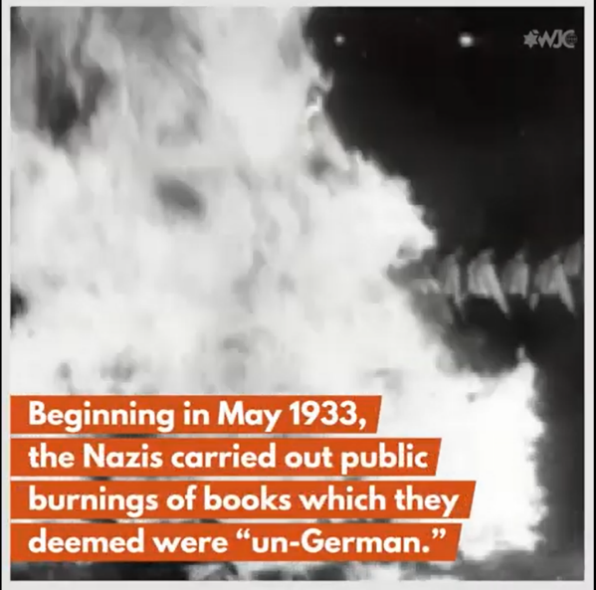
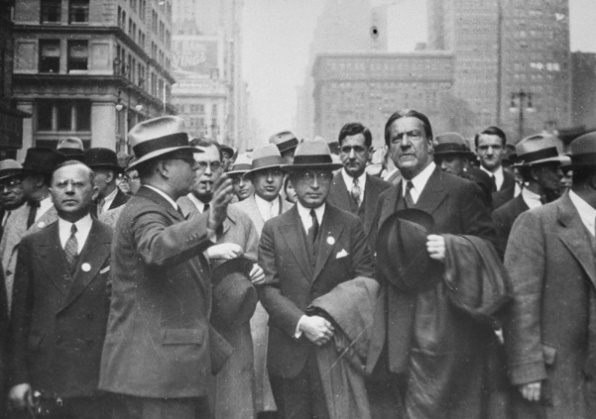
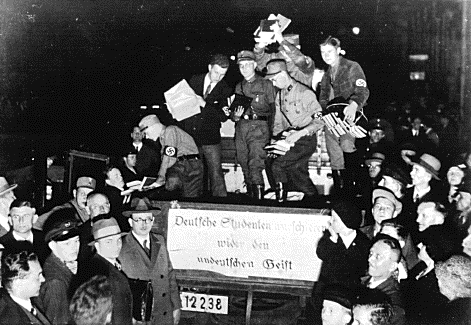
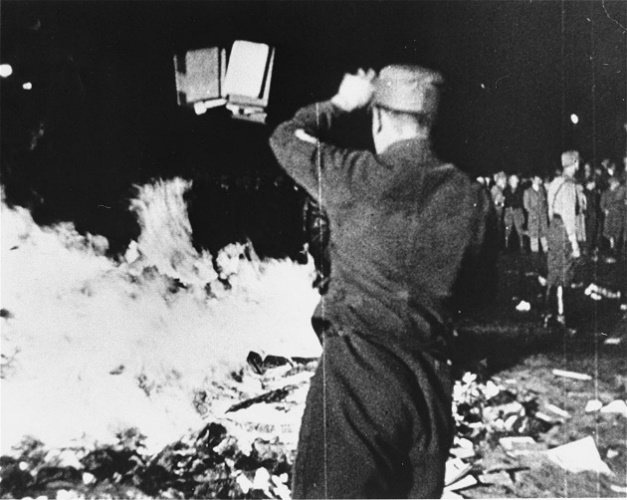
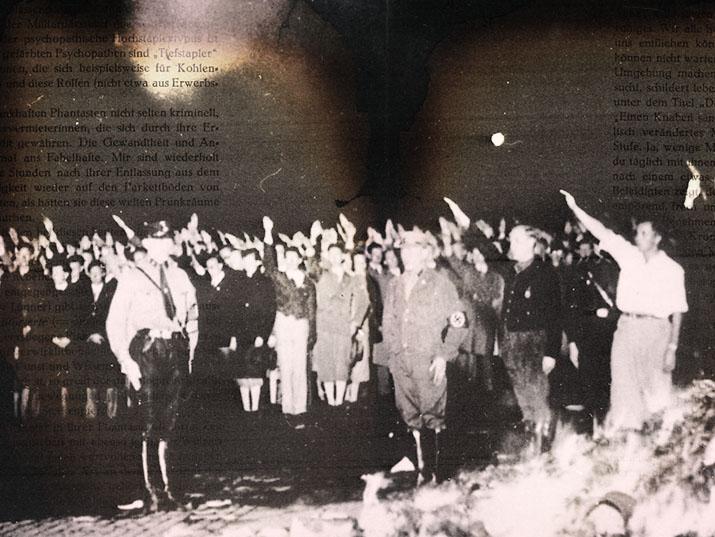
These artifacts are photo and video materials related to the described events. The first picture is a short film clarifying the types of books that the Nazis burned, and it will be used to introduce the period (World Jewish Congress, 2019). The second photo shows the response of American Jewish leaders to the event, which is helpful for reflecting people’s attitudes (The United States Holocaust Memorial Museum, n.d.b). The third and the fourth items are the process of burning books showing the participation of citizens, implying the link with the characters’ duty to conform (“Book burning,” n.d.a.; Naor, 2019). The fifth picture confirms the involvement of students, such as Liesel (“Book burning,” n.d.b). Thus, all these artifacts are connected to the novel as their combination serves as evidence of these occasions.
Articles
The above visual materials are complemented by articles on the topic. Thus, the first publication is “1933 book burnings” from the website of the United States Holocaust Memorial Museum (n.d.a) to provide background information on Liesel’s conditions. The second source is “The Two Pages that Survived the Nazi Book Burnings” by Amit Naor (2019), which is used for connecting political decisions and literature. The third item is “The Burning of the Books in Nazi Germany, 1933: The American Response” by Guy Stern (n.d.) for clarifying the universal nature of the problem presented in the novel. The fourth artifact is “Annette Kelm’s Photographs of Banned Books” by Kito Nedo (2020), which is helpful for recognizing the intellectual loss of the girl. The fifth article is about Thomas Mann, and it is critical for demonstrating the effects of the time on authors’ mindsets to complement the citizens’ response (The United States Holocaust Memorial Museum, n.d.c).
Related Literature
The ten artifacts described above can be introduced alongside other literary works expanding the understanding of the historical era in “The Book Thief” by Markus Zusak (2007). In the first place, they include poems written by young people in Germany when the described events happened. The selected pieces are “In Praise of the Führer,” “Adolf Hitler,” “Thoughts on the Führer,” and “German Girls Address the Führer!” reflecting the instilled values for the youth.
The above poems are to be presented alongside other books on the topic. First, “The Diary of a Young Girl” by Anne Frank (2015) is a diary of a girl whose experience in Nazi Germany will be useful for understanding that of Liesel. Second, the novel “The Boy in the Striped Pajamas” by John Boyne (2007) narrates about life circumstances of children in different families distinguished by the authorities, and it will help grasp the significance of one’s background. Third, “Girl at War” by Sara Novic (2016) is a story of another girl facing a world full of struggles, and it will allow compare Liesel’s perspectives with those of her peers. Fourth, “Man’s Search for Meaning” by Viktor Frankl (2006) is about spiritual survival attributed both to camp prisoners and children. Fifth, “The Tattooist of Auschwitz” by Heather Morris (2018) is a Holocaust story supporting Zusak’s narrative about human behavior.
References
Curriculum standards for social studies: Ten thematic strands. (n.d.) [PDF Document]. NGSSS_SS. (n.d.) [Word Document].
Book burning. (n.d.). A teacher’s guide to the Holocaust. Web.
Book burning. (n.d.). A teacher’s guide to the Holocaust. Web.
Boyne, J. (2007). The boy in the striped pajamas. David Fickling Books.
Frank, A. (2015). The diary of a young girl. Prakash Book Depot.
Frankl, V.E. (2006). Man’s search for meaning. Beacon Press.
Hitler youth poems in praise of Hitler. (n.d.). Calvin University. Web.
Morris, H. (2018). The tattoist of Auschwitz. Harper Paperbacks.
Naor, A. (2019). The two pages that survived the Nazi book burnings. The Librarians. Web.
Nedo, K. (2020). Annette Kelm’s photographs of banned books. Frieze. Web.
Novic, S. (2016). Girl at war: A novel. Random House Trade Paperbacks.
Rasinski, T. V. (1983). Using jackdaws to build background and interest for reading. 28th Annual Convention of the International Reading Association, 1-11. Web.
Stern, G. (n.d.). The burning of the books in Nazi Germany, 1933: The American response. Museum of Tolerance. Web.
The United States Holocaust Memorial Museum. (n.d.). 1933 book burnings. Web.
The United States Holocaust Memorial Museum. (n.d.). American Jewish leaders participate in a mass demonstration. Web.
The United States Holocaust Memorial Museum. (n.d.). Thomas Mann. Web.
World Jewish Congress. (2019, May 10). The Nazi book burnings: A history of hatred [Video]. YouTube. Web.
Zusak, M. (2007). The book thief. Knopf Books for Young Readers.